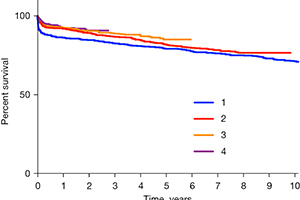Pulmonary thromboendarterectomy—the Royal Papworth experience
Abstract
Background: Pulmonary thromboendarterectomy (PTE) was first introduced to the UK 25 years ago, and the UK national service is provided by a single hospital. The aim of this work is to summarize our experience and review activity and outcomes by era at a high-volume PTE center. During this period the understanding of chronic thromboembolic pulmonary hypertension (CTEPH) increased and drug treatments and balloon angioplasty were developed. We also review our contribution to the better understanding of this surgery and CTEPH.
Methods: We retrospectively reviewed all patients undergoing PTE for CTEPH at our center between Jan 1997 and Sept 2019, dividing them into four equal cohorts. Pre-operative characteristics and post-operative outcomes are described by era. A MEDLINE search was performed and original scientific clinical publications from this unit were reviewed. Their contemporary relevance and influence to the evolution of the clinical service are discussed.
Results: Over this 23-year period from the commencement of our program, 2,116 consecutive PTE were performed. The mean patient age was 57.8 years (range, 11−89 years). The first 25% of our PTE were performed over 12 years whilst the most recent 25% were performed in less than three years. Over time, the average pre-operative mean pulmonary artery pressure has not changed significantly. The 30-day mortality by era quartile has progressively fallen from 12.3% to 1.9% most recently (P<0.001). Overall, one year survival exceeded 90%. 17 publications influenced our practice development during this period.
Conclusions: There was a consistent increase in activity and significant improvement in outcomes between the first and last quartiles of activity studied.
Cover






